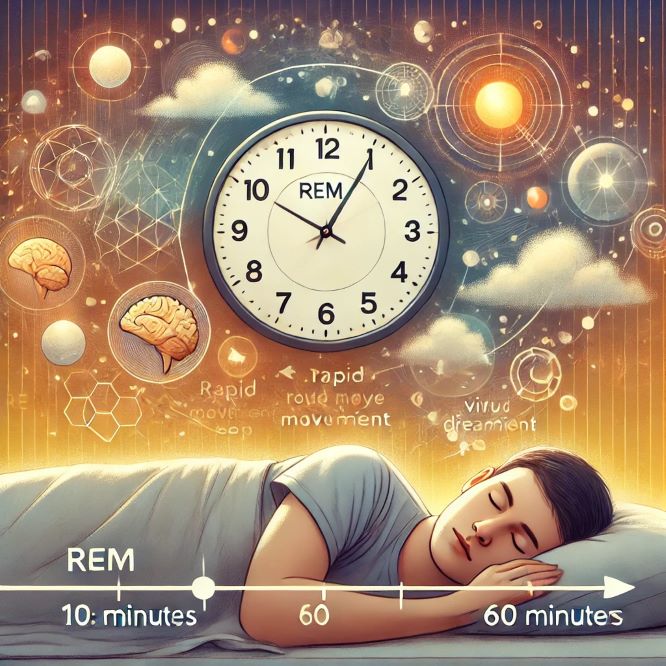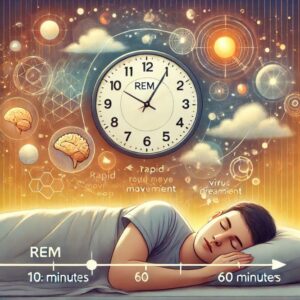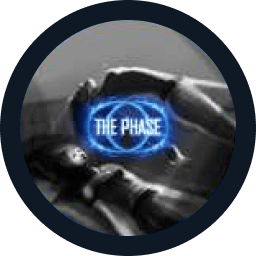It’s impossible to give a definite answer to the question ofhow long does REM sleep last. Research shows that its duration varies depending on age factors, overall health, and individual sleep characteristics. Itrepeats several times each night, altering its duration based on the sleep cycle.
What characterizes the rapid eye movement (REM) phase of sleep?
The REM phase plays a crucial role in restoring and maintaining brain function, as well as in processing and consolidating information received throughout the day. It is particularly vital for processes such as memory, learning, and emotional regulation, and its length directly affects sleep quality.
Characteristics of the REM phase REM sleep is a unified phase, not divided into additional periods. The main characteristics of this phase include:
- Increase in blood pressure;
- Elevated heart rate;
- Enhanced cerebral blood flow;
- Rise in serotonin levels;
- Rapid eye movements (REM) – a key fact revealed during laboratory studies;
- Increased breathing rate;
- Reduced activity of facial muscles.
Most people dream during the second half of the night, as the first half predominantly features NREM stages, during which the body restores physical resources and energy reserves. In the second half of the night, the REM phase becomes more prominent and is present in each cycle, promoting vivid and emotionally rich dreams.
How long does rem sleep last
The first 70-100 minutes of sleep involve NREM stages, primarily stages 3 and 4, characterized by deep slow-wave sleep. Given that the early part of the night mainly transpires in NREM phases, and the duration of the REM phase increases with each subsequent cycle, it occupies more time in the second half of the night.
Key points about the REM phase include:
- Cycle repetition occurs every 1.5 hours.
- The early part of the night features primarily stages 3 and 4.
- The duration of REM increases with each cycle.
- The total number of REM phase scan reach up to 6 times a night, depending on total sleep duration.
- On average, REM accounts for about 20% of total sleep time.
Immediately after falling asleep, deep and slow sleep predominates. One or two REM cycles may not occur at all. Assuming an adult’s sleep lasts 8 hours, the REM phaselasts approximately 96 minutes. The total duration of the REM phaseis distributed across cycles:
- The REM phase occurs after 1.5 hours, lasting no more than 10 minutes;
- In the second cycle – 10-20 minutes, with decreasing NREM phases and increasing brain activity;
- In the third and fourth – up to 25 minutes;
- Final cycles – up to 30-40 minutes. This is typical for the morning hours. Dreams are accompanied by the most vivid and lengthy narratives, most of which have a particular storyline.
If the sleep duration is shortened to 4 hours, the REM phase proceeds very quickly, unable to fulfill its numerous tasks. It is responsible for a myriad of processes in the body and brain function. Therefore, one should not sacrifice sleep, as insufficient time for the REM phase leads to a deficiency of serotonin and brain activity disorders.
Memory of dreams and the REM phase
Studies have shown that about 80% of people awakened during REM sleep can remember their dreams. If a person is woken up during deep sleep, they are likely to say they did not dream at all. Research using modern equipment has proven that during REM sleep, activity resembles a normal thought flow, while in deep sleep, vivid images and events arise, bringing a range of diverse emotions and sensations.
Remembering dreams is directly linked to the REM phase. Some people claim they do not dream. In reality, they simply may not be able to remember them. Sleep is cyclical, and the REM phase occurs several times during the night. Everyone goes through this stage regularly. Therefore, they certainly dream.
Research has also been conducted on the ability to remember dreams. It was found that people tend to recall and describe their dreams better if awakened during the REM phase in the latter part of the night. The nature and detail of memories depend on several factors, including the awakening method and the timing concerning the end of the REM phase. A sudden awakening leads to more vivid and detailed accounts of dreams, while a gradual awakening makes them more abstract and less rich.
Dream memory also deteriorates with the increased time that has passed since the end of the REM phase until waking up. The longer the time goes on, the harder it becomes for a person to recall their dream.
THE PHASE – A Practical Guidebook for Lucid Dreaming and Out-of-Body Travel
FAQ
Recommended reading
Human sleep phases – How they work
REM phase – What is it and what is it characterized by?
How long does the REM phase last
Rapid eye movement sleep (REM phase) – what is it and what is it characterized by









